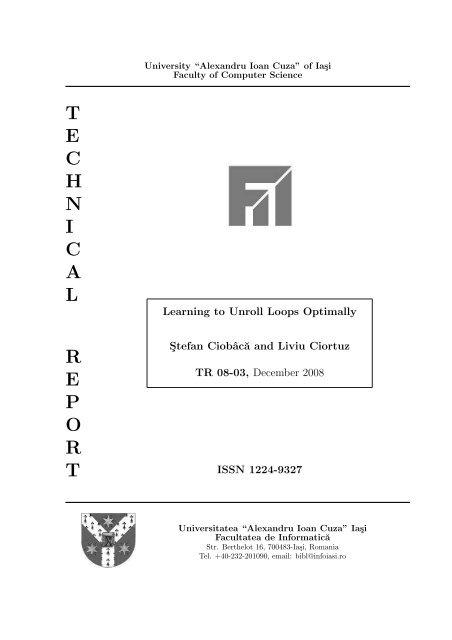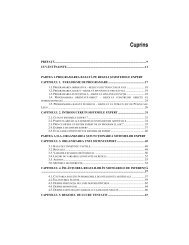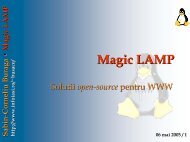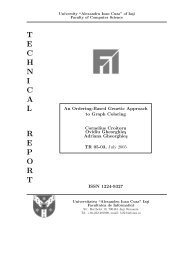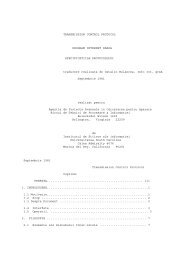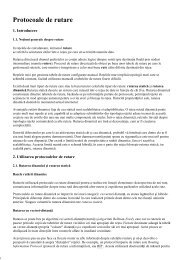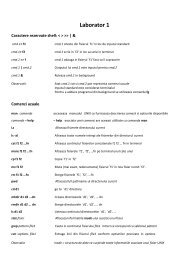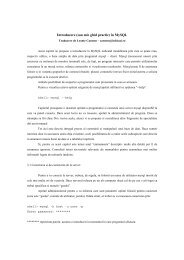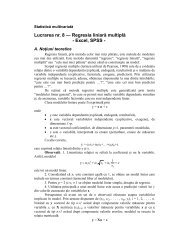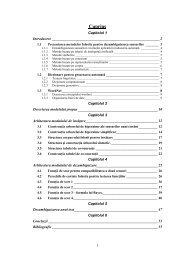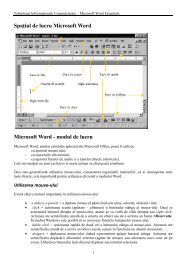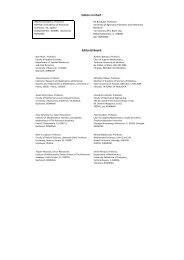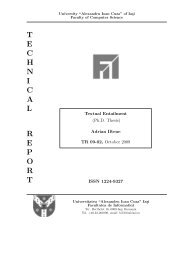Full document: PDF - Profs.info.uaic.ro - Universitatea Alexandru ...
Full document: PDF - Profs.info.uaic.ro - Universitatea Alexandru ...
Full document: PDF - Profs.info.uaic.ro - Universitatea Alexandru ...
Create successful ePaper yourself
Turn your PDF publications into a flip-book with our unique Google optimized e-Paper software.
T<br />
E<br />
C<br />
H<br />
N<br />
I<br />
C<br />
A<br />
L<br />
R<br />
E<br />
P<br />
O<br />
R<br />
T<br />
University “<strong>Alexandru</strong> Ioan Cuza” of Ia¸si<br />
Faculty of Computer Science<br />
Learning to Un<strong>ro</strong>ll Loops Optimally<br />
S¸tefan Ciobâcă and Liviu Ciortuz<br />
TR 08-03, December 2008<br />
ISSN 1224-9327<br />
<strong>Universitatea</strong> “<strong>Alexandru</strong> Ioan Cuza” Ia¸si<br />
Facultatea de Informatică<br />
Str. Berthelot 16, 700483-Ia¸si, Romania<br />
Tel. +40-232-201090, email: bibl@<st<strong>ro</strong>ng>info</st<strong>ro</strong>ng>iasi.<strong>ro</strong>
Learning to Un<strong>ro</strong>ll Loops Optimally<br />
S¸tefan Ciobâcă<br />
LSV, Ecole Normale Supérieure Cachan<br />
and CNRS<br />
94235 Cachan, France<br />
ciobaca@lsv.ens-cachan.fr<br />
Liviu Ciortuz<br />
Department of Computer Science<br />
“Al. I. Cuza” University of Iasi<br />
700483 Iasi, Romania<br />
ciortuz@<st<strong>ro</strong>ng>info</st<strong>ro</strong>ng>.<st<strong>ro</strong>ng>uaic</st<strong>ro</strong>ng>.<strong>ro</strong><br />
Abstract<br />
Every few months new types of hardware are released. Compiler writers face<br />
the challenging task of keeping the compiler optimizations up-to-date with the latest<br />
in hardware technology. In this paper we apply machine learning techniques<br />
to predict the best un<strong>ro</strong>ll factors for loops, using GCC and the x86 architecture for<br />
our experiments. We show that, depending on the machine learning tools used, we<br />
get similar or slightly better performance than the native GCC loop optimizer. Our<br />
result shows that machine learning techniques can be used to automatically train<br />
the heuristic that computes the un<strong>ro</strong>ll factor for loops, saving time for compiler<br />
manufacturers and p<strong>ro</strong>viding better performance in the case of scientific computations.<br />
1 Int<strong>ro</strong>duction<br />
Compiler writers develop heuristics to solve the p<strong>ro</strong>blems that occur during the optimization<br />
phases of the compilation p<strong>ro</strong>cess. Finding a heuristic for such a p<strong>ro</strong>blem<br />
is difficult and time consuming for the compiler manufacturer, especially when the<br />
compiler must work just as well on a number of different architectures.<br />
Common optimization goals include minimizing code size, maximizing speed and<br />
minimizing power consumption. Optimization is highly dependent on the target architecture<br />
of the system. What works well on the Itanium might not work so well on the<br />
x86.<br />
Among the most commonly used optimizations are:<br />
• function inlining consists of replacing the call to a function by the body of the<br />
function itself. This usually leads to bigger code, but, depending on the archi-<br />
1
tecture of the system and if the function is sufficiently small, performance is<br />
generally better.<br />
• local instruction scheduling consists of permuting instructions in a basic block<br />
(a sequence of instructions with one entry point and one exit point) in order to<br />
imp<strong>ro</strong>ve pipelining.<br />
• basic block reordering consists of rearranging basic blocks in order to reduce the<br />
branch cost and instruction cache misses.<br />
• loop un<strong>ro</strong>lling consists of replacing the body of a loop by multiple copies of<br />
itself, while reducing the number of times the loop is executed. This increases<br />
locality and reduces the number of jumps. The number of times the loop body is<br />
copied is called the un<strong>ro</strong>ll factor.<br />
All of the above optimizations were attacked by using tools such as machine learning<br />
or genetic algorithms. In [3], Cavazos and O’Boyle use a genetic algorithm to<br />
automatically tune the inlining heuristic of a dynamic compiler. In [2], Cavazos uses<br />
machine learning techniques to build flexible instructions schedulers. In [5], Liu et al.<br />
use neural networks to reorder basic blocks. In [4], Stephenson and Amarasinghe show<br />
how to predict un<strong>ro</strong>ll factors using supervised classification.<br />
However, very few articles describe experiments on a mainstream architecture/compiler<br />
combination, preferring for example the Itanium architecture or even simulators [2] of<br />
other architectures. In this paper, we concentrate on using machine learning techniques<br />
to predict the best loop un<strong>ro</strong>lling factors. We use the GCC [6] compiler (version 4.1.2),<br />
an x86 machine and the SciMark2 scientific benchmark [7].<br />
In section 2, we present the methodology used to gather experimental data and the<br />
algorithms used to learn the best un<strong>ro</strong>ll factor. Section 3 presents the timing data we<br />
obtained f<strong>ro</strong>m the experiments.<br />
In section 4 we check how the data we gathered f<strong>ro</strong>m the SciMark2 benchmark<br />
generalizes to a different benchmark [8] for a different language: Fortran. This was<br />
possible within our existing experimental framework because of the modular architecture<br />
of GCC (loops are un<strong>ro</strong>lled at the same place, both for C and Fortran).<br />
Section 5 concludes the paper and gives possible directions for future research.<br />
2 Methodology and Benchmark<br />
The SciMark2 benchmark was originally designed for testing the performance of different<br />
implementations of the Java virtual machine. However, the benchmark has been<br />
translated to ANSI C, and can be compiled using GCC. We chose the SciMark2 benchmark<br />
because it is freely available, fully self-contained, very easy to compile and it<br />
contains scientific code, which is amenable to loop un<strong>ro</strong>lling.<br />
There are five computational kernels in SciMark2:<br />
• Fast Fourier Transform (FFT) performs a one-dimensional forward transform of<br />
4096 complex numbers.<br />
2
• Jacobi Successive Over-relaxation exercises typical access patterns in finite difference<br />
applications.<br />
• Monte Carlo integration app<strong>ro</strong>ximates the value of π by computing the integral<br />
of the quarter circle y = √ 1 − x 2 .<br />
• Sparse matrix multiply exercises indirect addressing and non-regular memory<br />
references by multiplying sparse matrices.<br />
• Dense LU matrix factorization computes the LU-factorization of a dense matrix<br />
using partial pivoting.<br />
There are two versions of SciMark2: with normal data sizes and large data sizes.<br />
For the purpose of this paper, we only used the normal version of the benchmark.<br />
To obtain our training data, we modified GCC to output features for every un<strong>ro</strong>llable<br />
1 loop in the benchmark. There are 25 such loops in the SciMark2 benchmark.<br />
The following features were computed for each loop and saved for later use:<br />
Feature Name Explanation<br />
Loop Type (1 or 2) There are two ways GCC can<br />
un<strong>ro</strong>ll loops: if the loop tripcount<br />
is known at runtime<br />
(mostly for loops), GCC can<br />
apply a rather smart un<strong>ro</strong>lling<br />
algorithm, where the loop exit<br />
condition is tested for about<br />
n/f times, where n is the loop<br />
tripcount and f is the un<strong>ro</strong>ll<br />
factor. For other loops, the<br />
test condition must be replicated<br />
with each un<strong>ro</strong>ll.<br />
Instruction count The total number of instructions<br />
in the loop. This is the<br />
most useful parameter.<br />
Branch count The number of branches in the<br />
loop.<br />
Memory reads How many memory reads are<br />
performed in the loop body.<br />
Memory writes How many memory writes are<br />
performed in the loop body.<br />
Function calls How many functions calls<br />
there are in the loop.<br />
We then computed which one of 1, 2, 4, 8, 16, 32, 64 and 128 was the best un<strong>ro</strong>lling<br />
factor for each of the loops. To do this, we measured the benefits in terms of time for<br />
each loop and for each un<strong>ro</strong>ll factor.<br />
1 Due to technical constraints, GCC may not be able to un<strong>ro</strong>ll certain loops at all.<br />
3
One of the primary concerns is the preciseness of the collected timings. Timing is<br />
not a trivial task because the interference of the benchmark with other p<strong>ro</strong>cesses must<br />
be minimized. Instead of instrumenting the code to time how much each loop takes,<br />
we p<strong>ro</strong>pose a new scheme to measure the performance of loop un<strong>ro</strong>lling.<br />
To measure the gain of applying a certain un<strong>ro</strong>ll factor to a loop, we time the entire<br />
p<strong>ro</strong>gram, and not only the loop itself. This has the disadvantage of being slower 2 , but<br />
is more precise, because the effect of changing the un<strong>ro</strong>ll factor for a loop is measured<br />
ac<strong>ro</strong>ss the entire p<strong>ro</strong>gram.<br />
All tests were run on a 2.0GHz Pentium M machine with 1GB of RAM and 2MB of<br />
L2 cache, running Ubuntu 7.04. All non-critical services were shut down during the test<br />
run. Each experiment was run several times to minimize the influence of uncont<strong>ro</strong>llable<br />
factors on the results.<br />
We mark each loop with the un<strong>ro</strong>lling factor for which the benchmark performed<br />
best. On the resulting data, we apply the following machine learning algorithms:<br />
• DT 2: decision tree with two of the six features collected (number of instructions<br />
and number of branches)<br />
• DT 6: decision tree with all six features<br />
• NN: nearest neighbor with all six features<br />
To train the decision tree classifiers, we used the J4.8 algorithm, implemented in<br />
Weka [1]. We incorporated the classifiers into the GCC compiler (overriding the heuristic<br />
that GCC uses to calculate the un<strong>ro</strong>ll factor). We then measured the effect of un<strong>ro</strong>lling<br />
the loop in terms of speed.<br />
3 Results<br />
Figure 3 summarizes the results in terms of Mflops 3 . When compiled with no un<strong>ro</strong>lling<br />
whatsoever, the benchmark achieves 486.03 Mflops. When incorporating a random<br />
predictor (which chooses randomly and uniformly the un<strong>ro</strong>ll factor f<strong>ro</strong>m the set<br />
{1,2,4,8,16,32,64,128}, the score achieved is 506.04 Mflops 4 . The perfect classifier<br />
yields a score of 552.61 Mflops. This is thus the theoretical upper bound we can hope<br />
to achieve using the data we collected.<br />
Although during leave one out c<strong>ro</strong>ss-validation, only 28% of the loop un<strong>ro</strong>ll factors<br />
were classified correctly by the DT 2 classifier, it achieves a score of 528.84 Mflops,<br />
better than GCC’s built-in heuristic, which achieves 519.98 Mflops.<br />
When using all six features, the decision tree classifier yields a score of 537.35<br />
Mflops, 3.34% better than GCC’s heuristic.<br />
For the NN classifier, we only take into account loops for which the p<strong>ro</strong>gram performs<br />
significantly better when the loop is compiled with the best un<strong>ro</strong>ll factor (versus<br />
2Slower in the sense that for each loop and for each possible loop un<strong>ro</strong>ll factor, we have to time the entire<br />
p<strong>ro</strong>gram.<br />
3Millions of floating point operations per second.<br />
4The reason for this relatively important increase is that un<strong>ro</strong>lling is generally beneficial for scientific<br />
benchmarks.<br />
4
Figure 1: Performance of the different predictors, measured in Mflops over the entire<br />
benchmark suite (bigger is better). DT n represents the decision tree classifier with n<br />
features. NN is the nearest neighbor classifier.<br />
being compiled with the worst un<strong>ro</strong>ll factor). More exactly, we only keep loops for<br />
which this difference in performance is greater than 2.5 Mflops 5 .<br />
The resulting classifier, which obviously over-fits the data, is very close to the<br />
perfect classifier, yielding a score of 549.92 Mflops (the perfect classifier had 552.61<br />
Mflops). To minimize the effect of over-fitting, when we compute the nearest neighbor,<br />
we do not take into account the loop itself. This is very similar to leave-one-out c<strong>ro</strong>ssvalidation.<br />
The resulting classifier obtains a score of 524.92 Mflops, slightly better<br />
then GCC, but slower than both of the decision tree classifiers.<br />
4 Generalization to other Benchmarks and Languages<br />
To verify that our classifiers are valid, we p<strong>ro</strong>ceed to check how they perform on a<br />
different benchmark. We use the Polyhed<strong>ro</strong>n 2005 Fortran Benchmark [8] to test if the<br />
classifiers generalize to a different language and to a different benchmark.<br />
Of the three classifiers that we trained using the SciMark2 benchmark, the DT 2<br />
classifier performed best on the Polyhed<strong>ro</strong>n benchmark, achieving an average speedup<br />
of 5.77% over no un<strong>ro</strong>lling at all. However, the GCC loop un<strong>ro</strong>ller performed slightly<br />
better, achieving a speed up of 6.63%.<br />
Our results show that all three classifiers work well when used on this benchmark,<br />
but are not quite as good as the heuristic GCC uses. Table 4 shows the average running<br />
time of the 16 p<strong>ro</strong>grams that are included in the benchmark, when the loop un<strong>ro</strong>lling<br />
factor is computed by the corresponding classifier.<br />
5 Thus, only the critical loops were kept; in our case, 7 such loops remained.<br />
5
classifier average running time<br />
gcc heuristic 48.84<br />
no un<strong>ro</strong>lling 52.31<br />
decision tree (two features) 49.29<br />
decision tree (six features) 49.39<br />
nearest neighbor 49.65<br />
Table 1: Average running times in seconds (smaller is better) of the Polyhed<strong>ro</strong>n benchmarks,<br />
with different loop un<strong>ro</strong>ll classifiers.<br />
5 Conclusions and Future Work<br />
Using two different machine learning techniques (decision trees and nearest neighbor),<br />
we realized a 1.7% (decision tree with two features), 3.34% (decision tree with six<br />
features) and 0.95% (nearest neighbor) speed-up on a known scientific benchmark.<br />
In order to obtain the training data, we used a new app<strong>ro</strong>ach to benchmarking loops.<br />
Instead of instrumenting the code a<strong>ro</strong>und each loop to measure its performance, we<br />
measure the entire p<strong>ro</strong>gram for each possible un<strong>ro</strong>ll factor for each loop. This leads to<br />
imp<strong>ro</strong>ved accuracy of the training data, at the expense of the time required to collect it.<br />
Furthermore, we tested the imp<strong>ro</strong>vement obtained on SciMark2 with another industrystandard<br />
benchmark. The results suggest that the classifiers built with the first benchmark<br />
generalize to a different p<strong>ro</strong>gramming language (Fortran) and to a different benchmark<br />
suite quite well, but still not meeting the performance of GCC’s native loop un<strong>ro</strong>ll<br />
optimizer.<br />
It is worth noting that while the speed increases do not seem big, they are similar to<br />
the speed-ups obtained in [4]. Also, a modest increase in speed can result in significant<br />
savings in equipment and maintenance costs.<br />
Also, using machine learning techniques to learn optimizations is a benefit in itself,<br />
since the p<strong>ro</strong>grammer does not need to spend time hand-optimizing the compiler. This<br />
also encourages quick release and quick p<strong>ro</strong>totyping of compilers.<br />
The results are encouraging and suggest that future compilers may want to include<br />
a machine learning phase during the build of the compilers themselves. This way,<br />
architecture experts would only need to select the code features that an optimization<br />
depends on. The compiler could then use these features selected by the domain expert<br />
and learn how they map to the target objective function. The expert doesn’t need to<br />
spend time tuning the heuristic by hand.<br />
Future work should consider more benchmarks, such as the SPEC [9] benchmark,<br />
and more loop features and determine the effects that training the classifiers on one<br />
benchmark has on the running time of the other benchmarks. Many other types of<br />
compiler optimizations can be amenable to the machine learning techniques we used<br />
in this paper; it would be interesting to check which optimizations can be performed<br />
by machine learning algorithms and what degree of automation can be achieved.<br />
6
References<br />
[1] Ian H. Witten, Eibe Frank, “Data Mining: Practical machine learning tools and<br />
techniques”, 2nd Edition, Morgan Kaufmann, San Francisco, 2005.<br />
[2] John Cavazos, Using Machine Learning to Build Flexible Instruction Schedulers,<br />
Master’s Thesis, Department of Computer Science University of Massachusetts,<br />
Amherst, 1997<br />
[3] John Cavazos, Michael O’Boyle, Automatic Tuning of Inlining Heuristics, P<strong>ro</strong>ceedings<br />
of the 2005 ACM/IEEE conference on Supercomputing table of contents,<br />
2005<br />
[4] Mark Stephenson, Saman Amarasinghe, “Predicting Un<strong>ro</strong>ll Factors Using Supervised<br />
Classification”, P<strong>ro</strong>ceedings of the 3rd International Symposium on Code<br />
Generation and Optimization, San Jose, California, March, 2005.<br />
[5] Xianhua Liu, Jiyu Zhang, Kun Liang, Yang Yang and Xu Cheng, “Basic-block<br />
Reordering Using Neural Networks”, SMART’07<br />
[6] ***, The Official GCC website: http://gcc.gnu.org/<br />
[7] ***, SciMark2 Benchmark Website: http://math.nist.gov/scimark2/index.html<br />
[8] ***, The Polyhed<strong>ro</strong>n 2005 Fortran Benchmarks Website:<br />
http://www.polyhed<strong>ro</strong>n.com/<br />
[9] ***, The SPEC Benchmark Website: www.spec.org<br />
7


